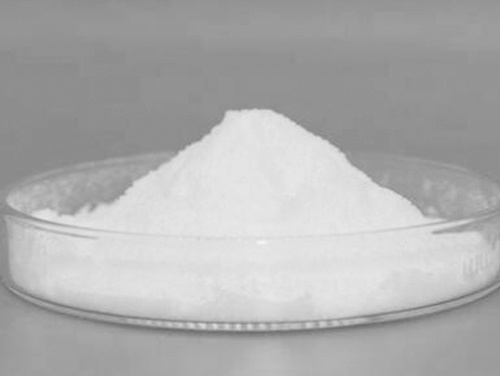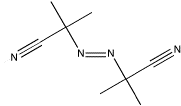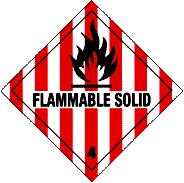

Material Safety Data Sheet(V60)
|
2,2'-Azobis(2-methylpropionitrile) |
|
|
· 2,2'-Azobis(2-cyanopropane) · 2,2'-Azobis[2-methylpropanenitrile] · 2,2'-Azobis[isobutyronitrile] · 2,2'-Dimethyl-2,2'-azodipropionitrile · Azodiisobutyronitrile · Azobisisobutyronitrile |
|
|
Formula |
NC(CH3)2CN=NC(CH3)2CN |
|
Structure |
|
|
Description |
White solid. |
|
Registry Numbers and Inventories. |
|
|
CAS |
78-67-1 |
|
EC (EINECS/ELINCS) |
201-132-3 |
|
EC Class |
Explosive; Highly flammable; Harmful; Dangerous for the Environment |
|
R 2 11 20/22 52/53 |
|
|
RTECS class |
Other |
|
UN (DOT) |
3234 |
|
Beilstein/Gmelin |
1708400 |
|
Swiss Giftliste 1 |
G-3625 |
|
Canada DSL/NDSL |
DSL |
|
US TSCA |
Listed |
|
Austrailia AICS |
Listed |
|
Japan ENCS (MITI) |
Listed |
|
Korea ECL |
Listed |
|
Properties. |
|
|
Formula |
C8H12N4 |
|
Formula mass |
164.21 |
|
Melting point, °C |
80 |
|
Boiling point, °C |
236 |
|
Density |
1.08 g/cm3 |
|
Solubility in water |
Slightly soluble |
|
Partition coefficient, pKow |
1.26 |
|
Heat of vaporization |
47.3 kJ/mol |
|
Hazards and Protection. |
|
|
Storage |
Keep away from heat, sparks, and flame. Keep away from sources of ignition. Store in a tightly closed container. Store in a cool, dry, well-ventilated area away from incompatible substances. Refrigerator/flammables. |
|
Handling |
Wash thoroughly after handling. Minimize dust generation and accumulation. Use spark-proof tools and explosion proof equipment. Avoid contact with eyes, skin, and clothing. Keep container tightly closed. Avoid contact with heat, sparks and flame. Do not ingest or inhale. |
|
Protection |
Eyes: Wear appropriate protective eyeglasses or chemical safety goggles as described by OSHA's eye and face protection regulations in 29 CFR 1910.133 or European Standard EN166. Skin: Wear appropriate protective gloves to prevent skin exposure. Clothing: Wear appropriate protective clothing to prevent skin exposure. |
|
Respirators |
Follow the OSHA respirator regulations found in 29CFR 1910.134 or European Standard EN 149. Always use a NIOSH or European Standard EN 149 approved respirator when necessary. |
|
Small spills/leaks |
Remove all sources of ignition. DO NOT CLEAN-UP OR DISPOSE OF, EXCEPT UNDER SUPERVISION OF A SPECIALIST. |
|
Stability |
Substance is shock sensitive and thermally unstable. |
|
Incompatibilities |
Acetone (possible explosive decomposition); Heptane (possible explosion with the addition of heat) |
|
Decomposition |
Hydrogen cyanide, carbon monoxide, carbon dioxide. |
|
Fire. |
||||
|
Flash Point,°C |
97 |
|||
|
Autoignition, °C |
64 |
|||
|
Fire fighting |
Wear a self-contained breathing apparatus in pressure-demand, MSHA/NIOSH (approved or equivalent), and full protective gear. Exposure to heat may promote violent decomposition. During a fire, irritating and highly toxic gases may be generated by thermal decomposition or combustion. Flammable solid. May be ignited by heat, sparks, and flame. Self-accelerating decomposition may occur if the temperature is not maintained. Material is sensitive to temperature rises. Above a given"control temperature"they decompose violently and catch fire. May decompose explosively when heated or involved in a fire. Vapors or dust may form explosive mixture with air. May burn violently. Decomposition may be self-accelerated and produce large amounts of gas. Extinguishing media: Use water spray to cool fire-exposed containers. For small fires, use dry chemical, carbon dioxide, water spray or regular foam. Cool containers with flooding quantities of water until well after fire is out. |
|||
|
Fire potential |
Self-decomposition or self-ignition may be triggered by heat, chemical reaction, friction or impact. Self-accelerating decomposition may occur if the specific control temperature is not maintained. |
|||
|
Hazards |
These materials are particularly sensitive to temperature rises. Above a given"Control Temperature"they decompose violently and catch fire. May be ignited by heat, sparks or flames. May burn violently. Decomposition may be self-accelerating and produce large amounts of gases. Vapors or dust may form explosive mixtures with air. |
|||
|
Combustion products |
May produce irritating, toxic and/or corrosive gases. |
|||
|
Health |
3 |
|
|
|
|
|
Flammability |
3 |
|
|
|
|
Reactivity |
3 |
|
|
|
Health. |
|
|
Poison_Class |
1 |
|
Exposure effects |
|
|
Ingestion |
May be fatal if swallowed. May cause gastrointestinal irritation with nausea, vomiting and diarrhea. May cause liver and kidney damage. May cause degenerative brain changes. |
|
Inhalation |
May cause respiratory tract irritation. Repeated exposure may cause liver damage. |
|
Skin |
May cause skin irritation. |
|
Eyes |
May cause eye irritation. |
|
|
|
|
Ingestion |
If victim is conscious and alert, give 2-4 cupfuls of milk or water. Never give anything by mouth to an unconscious person. Get medical aid immediately. |
|
Inhalation |
Remove from exposure to fresh air immediately. If not breathing, give artificial respiration. If breathing is difficult, give oxygen. Get medical aid. |
|
Skin |
Immediately flush skin with plenty of soap and water for at least 15 minutes while removing contaminated clothing and shoes. Get medical aid if irritation develops or persists. |
|
Eyes |
Immediately flush eyes with plenty of water for at least 15 minutes, occasionally lifting the upper and lower eyelids. Get medical aid immediately. |
|
Transport. |
||
|
UN number |
3234 |
|
|
Response guide |
150 |
|
|
Hazard class |
4.1 |
|
|
HS Code |
2927 00 00.90 |
|
OFFICIAL ACCOUNTS
Welcome to the mobile company website

CONTACT INFORMATION
ONLINE MESSAGE
Zibo Huidong Chemical Technology Co., LTD Copyright Lu ICP 2023010031 No.1
 China
China English
English



